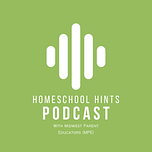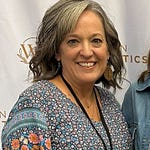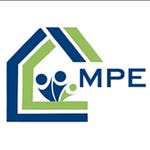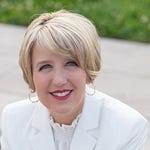TRANSCRIPT
Shanxi: Hello, this is Shanxi Omoniyi, host of MPE’s “Homeschool Hints” podcast to encourage you wherever you may be on your homeschool journey.
Today we're going to discuss kindergarten readiness, which is something that a lot of new homeschool families can feel very intimidating. Suzanne Wandling is our featured speaker. Her specialty is in elementary and special needs education. And Suzanne, can you tell us a little bit about what homeschool kindergarten looked like for you?
Suzanne: Yes, kindergarten is such a special time. I have such fond memories of that season with our two girls, and our time was very play based. We spent a lot of time with simple repetitive learning activities, doing things like fine-motor activities, like stringing beads and sorting toys by color and cooking real and pretend. We spent a lot of time cutting bananas with plastic knives and rolling out play dough to make play pizzas and cookies. And we did a lot of movement activities just to help kids develop their bodies. That included skipping and hopping and leapfrog. So we did a lot of things before we ever got to the academic side of things.
And then we segued into pre-academic activities. One of the favorite things our girls did was we had a foam alphabet that we would put on the floor and they would jump from letter to letter, and they would spell their name, and it was really fun. We were moving and they were learning.
We also made letters in cornmeal, and numbers. One of my daughters loved cornmeal, so we always had a pan of cornmeal sitting aside that we could just grab just for that activity.
But then we also did some pre-learning things, like we counted beans, and we counted toys and animals, and we measured a lot of water with measuring cups <laughs> and just had a lot of fun with that. So just really laying a foundation to be excited to learn before kindergarten, and then when we started with our actual kindergarten, we used a very simple curriculum, focused a lot on language and just really focused a lot on fun and play-based learning.
Shanxi: Wow, that's so exciting to hear because I know so many people feel this pressure nowadays to make homeschool kindergarten, you have to get your child reading by the end of homeschool kindergarten or else they’re going to be falling behind. But what you were saying doesn't sound intimidating at all. What would you say are some common misconceptions or myths about elementary education, especially in the kindergarten years?
Suzanne: Yes. And there are some students that will be reading at the end of kindergarten because they're developmentally ready. But the great thing about kindergarten is you're really looking to go with your child's ability level. If I understand correctly, the right side of the brain is developing first and then the left side of the brain. And so, the left side of the brain is responsible for developing reading skills.
So if you have a child who's still developing the left side of their brain, and you're trying to teach them how to read. That can be very frustrating and overwhelming, and they can really shut down to the learning process.
So a lot of kindergarten is figuring out if your student is ready for a particular curriculum. If you have a very strong play and language-based curriculum, one child might be ready for that, but if you have one that's more academics, and they're starting with letter development and number understanding and one-to-one correspondence, then that's OK too.
Kids are radically different in their developmental phase here, and so it's really important to be curious about your child and really just dig into where they are and what they're ready for.
You know, the world is on hyper speed, wouldn't you say? And so kindergarten is not hyper speed. Maybe another misconception about kindergarten is that you just do a lesson once and they go to the next thing.When you're working with the little person, it might take them 1, 2, 5, 10 times to conceptualize something, and you want to either have a curriculum that loops and builds that in, or be mindful of that so that you can help them just master the skills that are before them.
Another misconception is that you have to sit down. You have to sit at a little desk and you have to do all of school in a 2-foot-square box, right? And there’s nothing further from the truth. When we start learning, it's really helpful to start your day with movement, so you might take a short walk or go for a bike ride, play game, hopscotch, or jump on the trampoline just to get the brain moving and the body moving at the same speed, and then find a comfortable place to start your learning which could be on the floor or at a table. Goal or it just really depends on the activity, but those are just some things that that stick out to me.
Shanxi: Yeah. Thank you so much. What is the general attention span that a parent should expect during the kindergarten years? As you know, homeschooling kindergarten doesn't have to look at all like a traditional classroom.
Suzanne: Well, the good thing and the challenging thing is the teaching parent has, the average attention span for kindergartener is 8-18 minutes. There you are: turning to conquer the world in 8-18 minutes.
I think the thing that's helpful when you're working with young kids is to provide a learning opportunity and provide an opportunity to practice it. Do a hands-on activity and then possibly take a break, or if their attention span is going longer, you can alternate a challenging activity with the review activity just to keep them excited about learning.
So for example, if you have a student that's practicing the letter B, and they're enjoying it and it's going really well, then you can stay on that activity, you know. But if you see that they're starting to get tired, then just go ahead and take a break. Do something different, do a movement break.
We used to always keep dice at our desk where we were learning, and we would throw the dice and that's how many jumping jacks, we would do or army crawls under the table. So it's just a matter of looking at the threshold, you know what it is. They start falling out of their chair or, you know, rolling their eyes. <laughs>
Shanxi: If you know parents are the kind of people who are, you know, looking online and they're searching for, you know, the academic milestones at their kindergarten, they should achieve. I know I personally was always encouraged by how simple they tended to be in the kindergarten levels, like counting from one to 10, two step directions. Being able to use child-safe scissors appropriately. What are other developmental milestones that you think are important for parents to remember and keep in mind?
Suzanne: That's a great question. One thing that's really helpful is a concept called hand dominance, and that is where your student is using one hand predominantly to write or draw or color or pick things up.
That's really important as you might imagine, in planning to start the learning process. Another one is being able to identify shapes. Maybe writing some letters, not a lot of letters, but just the concept that letters mean something, and so there's something called print awareness. So that's knowing how to handle a book, knowing that the letters on the page make up words.
Just starting to get developmental understanding of what print and books are, and then maybe some simple understanding of counting. There's a concept called one-to-one correspondence. Maybe just being able to count the 10 objects, but being able to say one bean is 1, 2 beans is 2, and just start beginning to have that concept.
There are many, many things that experts recommend, but I really come back to what your child is doing when looking at it. I found a kindergarten readiness checklist that I found really effective on teachingmama.org.
And I really appreciated the list that she came up with because it includes verbal skills and listening skills because there's so much to learning. A student needs to be able to listen to a short excerpt from a book to start school. You know, when they're showing interest in that, that means they're starting to show interest in learning.
Shanxi: What if parents are listening to this and they're thinking, my child may have some challenges with maybe some of the milestones you mentioned? Or they're thinking, you know, just down the road about maybe special-needs diagnoses or other questions that they have about their kindergartener. What resources would you recommend they check out or what next steps should they take?
Suzanne: That's a great point. So some possible red flags, just to give you an idea what a parent might look for initially, would be if they're saying they're trying to say the word barn and their word retrieval comes up with the word house.
So if you see a pattern where they're not able to identify a word that they're wanting to say, if they're forgetting how to form the letters in their name and they've written it many, many times, but they're continuing to need assistance, that could be a red flag.
Maybe still working on hand dominance.
Another thing to look for is, say you're doing a phonemic awareness activity. You're reading a poem or something, and you ask them what the rhyming words are, and they just are not having a concept of that the last one, because phonemic awareness is an indicator of success in reading, and that's just being able to hear and manipulate sounds.
If you ask a student to do an activity, say for example, we're going to say the word cat and the first sound in cat is “c.”
But we want to change that to a “b,” what's our new word? The new word is bat.
Well, if they're having a hard time coming up with that new word, it might be they're having a hard time with phonemic awareness, and so that could be a challenge as well. There's a book called Slow and Steady, Get Me Ready that I love. That shows you step-by-step milestones from birth to five that can show you some activities to do to develop some of those things.
Another thing you can do is meet with a pediatrician or a specialist and have a screening done, so someone like myself could do just a brief screening to say, Oh yeah, we see, there's maybe some reading concerns or you just need more exposure.
Sometimes kids just need more time. And that's the hard thing about little ones. Sometimes there's a true challenge, and sometimes they just need more practice.
So just in general, you start with your fine motor activity. You might roll out play dough and make play dough shapes to warm up your hands. Again, like I mentioned before, play hopscotch or jump on the trampoline just something to get moving. Then you might have your Bible time. I'd encourage you to have some pictures of little people or places or something to go with them to kind of tell a story to go with it.
And then I always jumped into handwriting first. They're excited to write their name. That's kind of a big deal. And so just starting with a few letters or the letters that are providing your curriculum to get started. Good literature sitting and reading together.
I spent a lot of time encouraging families to work on their handwriting in conjunction. With their beginning reading skills, it's very common for families to say, well, handwriting is really hard, so we don't do it, and I get it. It's hard. It's hard to teach. Little hands don't always do what we want them to, so it can be frustrating.
Some things you can do with your little handwriting is have them write letters in the air or write letters in cornmeal, like we talked about, or some families like to make chocolate pudding and make letters in chocolate pudding.
But there is a method to the madness, because the multi-sensory opportunities to learn provide an opportunity for them to practice and practice and practice, and so you want to include a lot of that.
I've encouraged families to model, model, model, and then model some more because it helps the student to see what you're wanting to work on and the correct way for letter formation and there is a direct relationship between writing and reading, and so if you're doing that well early on, you're going to have a reader and a writer together, which is going to be a success.
Following that, I might take a little break because breaks are good. You've probably hit your 18 minutes twice by now. Come back later and do a math activity. You know, hands-on curriculum activity with shapes or numbers, and so just really breaking up the day. I like to work in blocks.
When I first started homeschooling, someone said, well, you need to schedule, and my personality is not scheduled, so I thought I was going to die. <laughs> But then I realized, just because it wasn’t my personality didn't mean I have to do it. So I figured out how to work in blocks, if you will. So I would do blocks of time throughout the day. I had the leisure to do that at that time, so it was good for me and our kids to just have blocks of time.
Shanxi: Yeah. And it's so lovely to be able to customize your schedule or your blocks of time to your child, because sometimes one child will love to just sit down and focus, and another child will just love to hop from one activity to the next.
Suzanne: Right, right. And. And that's a great observation because you really want to be curious about your child and press into that as much as you're able for sure.
Shanxi: Yeah. Are there any other free or low-cost resources you recommend for parents in homeschooling kindergarten?
Suzanne: Yes. One of the things that we use when our kids were very young was the Before Five in a Row curriculum. It's very inexpensive, and it covers all the bases for learning. I loved it because you read the same story for a whole week and you learned about what literature was. You learned print awareness, you learned letters and science and Bible. And it was very easy to implement. So I loved that.
I also mentioned already Slow and Steady, Get Me Ready. That book is for children, birth to five and it gives you one to two activities per week with things that you have around your home. So for example, they might show you how to string beads for, like, a 3-year-old or 4-year-old, but what’s good about it is it's intentional and developmental based on your students’ age. And by the time you go through the whole book, then they're ready for kindergarten. That's kind of interesting. We use that book.
There's another curriculum called UFLI. And it's from the University of Florida Literacy Institute. They have a free online curriculum that teaches you how to teach with the science of reading curriculum, which is really nice. That's a favorite that I like to use.
And then All About Reading is a classic curriculum that's really utilized by a lot of homeschool families. So I think it's a good one to jump into. I do like the spelling with it. Even though they say you don't need spelling from the beginning, I'm kind of a fan of a lot of writing.
Shanxi: Anything else that you think is important for first-time families to remember when they're preparing for this milestone in their children's lives?
Suzanne: I think the main thing about kindergarten is kindergarten is the gift of time, and an education is a lifelong pursuit.
So really enjoy being curious about your child and where he or she is and developmentally and if they're ready for kindergarten.
And if you need to step back and do some pre-K activities or spend more time, do a two-year kindergarten loop, then be OK with that.
Because you're setting your child up for success in kindergarten, and so just begin at the end of mind, remembering that our kids are a work in progress like in Philippians 1:6.
I think that the world is out here and it's noisy and it's big and it's fast, but really just taking time to look at each child like you were saying before, you have one who's speeding through life and one who just really needs to take it just one hour at a time. Being in tune to that and creating a joy of learning is going to be a big deal and letting them be who they are as a learner.
Is it OK if I share two lags I've noticed because of COVID and technology?
Shanxi: Sure.
Suzanne: We've noticed a lag in fine motor skills that students are being exposed earlier and earlier to technology in lieu of pencils and crayons and markers. And play dough and lots of different things and scissors. And so really, spending a lot of time prior to kindergarten or during kindergarten and 1st grade with fine motor skills is going to make their school experience more pleasant because they're going to be able to write more efficiently.
And the other thing is, technology is reducing the effectiveness and breadth of language in young kids. And so, you know, if you see someone handing a student an iPad at a very young age, that's robbing them a little bit of language because it's a very passive activity.
And so, just thinking of different ways to do fingerplays and rhymes and all those different things that we did when we were younger are still very important, and lots of fun, and make a big impact on learning. So just be messy and have fun. The learning will come.
Shanxi: Yes. To that point about, you know, developing the richness of language. Are there any resources that you can recommend to, for example, get your child exposed to more language, to more communication, to more expression of language?
Suzanne: One of my favorite ways to do that is through poetry and finger plays and rhymes, because you can have lots of different voices you can play with language. There's lots of visualization, there's fine motor movements.
One of our games was synonyms or words that mean the same, and so that we would try to come up with, we would snap and try to come up with two words that meant the same and just we just really developed a love of words in our kids.
And so to this day, they're young adults, they’ll come up, someone will say, have you used this word? Have you heard of this word? It's really just you being excited about language and sharing words and they all kind of catch on to that. It's really fun.
Shanxi: Thanks so much for listening. We hope you are encouraged in your homeschool journey.
Please continue the conversation with us on our website, midwesthomeschoolers.org, or email us at podcast@midwestparenteducators.org. We're also active on social media if you'd like to connect with us there. Thanks to Kevin McLeod of incompetech.com for providing this royalty-free song Wholesome, which is licensed under creativecommons.org.










Share this post